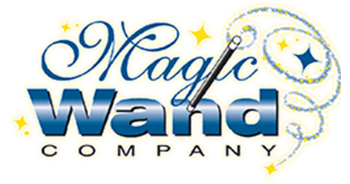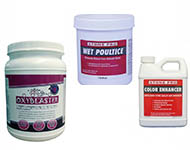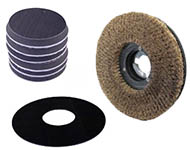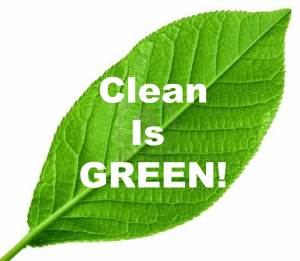Forward by Taf Baig
The most common question I get is what makes a carpet cleaning chemical green? So, I thought instead of just me talking about it, we should 1st read this article about what Green Cleaning is by Dr. Michael Berry who has more than 28 years of experience at the Environmental Protection Agency – EPA.
The Green Movement and Science
Eight green cleaning myths to consider.
by: Dr. Michael A. Berry
Green carpet cleaning
“Environment” is the set of all living and non-living surrounding conditions that affect the life of an organism. In our case, the organism of primary concern is human.
Humans are inextricably bound to their environment. It is impossible to be human and at the same time isolated from environmental processes and conditions.
Here are some examples:
- Every element in the human body comes from the environment
- Humans are fed and receive life-sustaining energy through the environment
- Humans are healed and kept healthy by the environment
- Humans create and expand the basic sciences by observing the environment
- Humans use the environment to apply sciences and practice arts
- Humans use the environment for recreation and to interact socially
- Humans use the environment as a unique form of capital to run economies and businesses and to acquire sufficient wealth, which ensures health, security and an acceptable level of human existence.
Humans show concern for the environment because it is in their health, economic, creative and recreational interests to do so.
Humans cannot disconnect from a life-essential environment any more than a space-walking astronaut can disconnect from a life-sustaining pressurized space suit and oxygen supply.
No matter how technically advanced humans are, humans need the environment to live and prosper.
Environmental awareness
This is the age of environmental awareness; some call it the age of “green.”
“Green” is a code word for environmental protection. “Green” is a symbol of value, respect, and concern for the life-sustaining processes and cycles of the natural environment system of which we are all a part and the conditions of our built environment over which we have the most control.
The concept of “green” has traditionally centered on the reasonable and responsible conservation of natural resources, pollution prevention, waste minimization, and recycling to prevent unwanted matter in the form of wastes and pollutants from causing harm to the natural system and human health.
The concept of “green” in this context is a useful and commendable symbol.
However, in recent times, a darker side to “green” has emerged. Far too much of what we hear about our environmental condition today is “green babble.” “Babble” is nothing more than an undisciplined, fact-less conversation. It has no basis in science. But it is also not only useless, but it is also often deliberately misleading to sell something or promote a political position.
Increasingly political verbiage and commercial advertisements related to “green” are completely irrelevant to the protection of human health and natural environmental processes. “Green babble” is often superficial to the point of being idiotic and often misleading to the point of being socially destructive.
Factual knowledge of how the environment works (science), along with effective management, is what protects and sustains the environment — not political correctness, green slogans, labels, and superficial certifications.
The following are some “green myths” related to cleaning which have evolved in recent times.
Myth #1: Environmentalism is a science-based movement to save the environment
During the past 40 years, environmental management and protection has gone from an engineering pursuit of putting waste in its proper place to a zealous political and popular culture-based movement called “environmentalism.”
The suffix “ism” indicates a distinctive system of “beliefs” that guides a social movement, often undertaken by an elitist class of people. Unfortunately, environmentalism takes on cult-like, group-think characteristics.
Environmentalism exploits the love of environment tendencies that all humans possess. There is a name for those tendencies, “topophilia.”
Environmentalism is, for the most part, not science-based.
Science is most often completely ignored or deliberately misrepresented by environmentalists to achieve political, social or business objectives.
Environmentalism beliefs about the environment are often not based on rational facts; they are often based on irrational feelings, emotions, and political correctness.
Regardless of what environmentalists and politicians say they “believe” to be an “inconvenient truth,” without science and factual information we cannot identify and manage the essential conditions for life and human health.
The environment is not for the pleasure of the elite. In our free society, all citizens have the right to take a hard look at and question the facts behind environmental policies and programs, especially those affecting their lives.
Anyone who seriously cares about effective and responsible environmental management should challenge environmentalists: “Show me your data. Demonstrate to me by way of scientific methods, measurement, and data how your beliefs and preaching protect the environment and contribute to the betterment of human life on the planet.”
Frequently, those who do not adhere to the beliefs of environmentalism are put on guilt trips, berated, disenfranchised and presented as being stupid, irresponsible or uncaring.
Under no circumstance should a professional carpet cleaner allow him or herself to be put on a “green guilt trip.” Professional cleaning began about 200 years ago with the “Sanitation Revolution,” long before this “age of green.”
Effective cleaning has done more to protect and extend life expectancy and protection of human health than any single event in human history.
Cleaners or sanitarians were taking care of the environment long before environmental activists and green chemical salesmen arrived on the scene.
Myth #2: Cleaning is an inherently polluting activity
Cleaning is in no way polluting. “Clean” and “green” can be complementary concepts.
“Clean” is a condition free of unwanted matter. “Matter” is anything of substance that has mass and is influenced by gravity.
Substances are of three forms: Solids, liquids, and gases.
Substances can be living or nonliving. Matter can be measured and described quantitatively. The unwanted matter is any substance that gets in the way of human endeavors, poses a risk or causes an undesirable or adverse effect.
We often refer to this type of matter as pollution. It goes by many other names including waste, soil, dirt, dust, trash and pathogenic microorganisms.
“Cleaning” is the process used to achieve the clean condition. Cleaning can be best viewed as the fundamental environmental management process of putting unwanted matter in its proper place, thus ensuring a sustainable functioning environment.
Effective cleaning is the process of removing the unwanted matter to the greatest or optimum extent, thus ensuring acceptable risk — the reduced probability of an adverse effect — for humans, valuable materials and the natural environment from exposure to the unwanted matter.
By definition and design, effective cleaning is fully protective of the environment. Effective cleaning is characterized by the following criteria is fully protective of the environment:
- Maximized measurable removal of pollutants from the environment or sub-compartment
- Minimum amounts of cleaning derived chemical, particle and moisture residue
- Cleaning for health first and appearance second
- Recognition of environmental compartment connectedness and measurably improved quality of the total environmental system
- Safety
- Pollution prevention and waste minimization
- Proper disposal of cleaning wastes.
Effective cleaning is a science-based high-performance management process.
The effectiveness of any cleaning system resides in the comprehensive, coordinated, scheduled, systematic cleaning coverage of the building and its connected compartments; the measured quantity of unwanted matter removed from the presence of humans and valuable materials; the use of cleaning equipment and technology tested and evaluated for effectiveness and safety; and the professional training of the cleaning staff at both the management and operational.
A high-performance cleaning process or program is one that achieves an effective cleaning result on a consistent or sustained basis through the application of quality based management principles and proven management competencies.
Myth #3: Carpet cleaning poses special risks to humans and the environment
More than 25 years ago, I wrote an article for carpet cleaners and I told them that when they practice their craft professionally they protect human health and contribute much to reduce human exposure to unwanted substances and improve the quality of the indoor environment.
I told them then, as I am telling readers now, professional cleaners are managers and guardians of the environments to which humans are exposed the vast majority of their life.
Let’s be clear in regards to “environmentally protective carpet cleaning.” High-performance — environmentally protective — carpet cleaning is a formally structured process of:
- Unwanted substance awareness: Knowing or locating unwanted substances in the carpeted walk-off areas or high traffic areas, as an example
- Identifying the nature of those substances so that the proper technology can be applied to remove them
- Effectively containing the unwanted substances so they can be removed from the carpet and not transferred to some other indoor compartment
- Removing the greatest amount of unwanted mass with the least amount of unwanted residue
- Properly disposing of the unwanted substances where they will not be a problem somewhere else.
Cleaning carpet is most beneficial to health when we extract all of the following:
- Fine particles not controlled through normal housekeeping methods, such as frequent vacuuming
- Particles to which other pollutants, such as solid and gas-phase organic compounds, are bound
- Biological allergens of all types
- Heavy metals such as lead, cadmium, and arsenic found in outside soil dust
- Pesticides and herbicides used in and around the microenvironment
- Combustion byproducts from cooking, wood smoke, candles, and tobacco.
The benefits of extracting pollutants from carpet include:
- Reduced health problems from loose particles
- Reduced cases of biologically induced illness
- Reduced lifetime cancer risks
- Reduced complaints for building owners and managers
- Reduced liability for building owners and managers.
So, what’s not “green” or environmentally protective about carpet cleaning?
Myth #4: Conservation is the key to environmental protection and sustainability
In looking at unhealthy conditions anywhere around the world, we find that the root causes of environmental degradation are poverty, ignorance, mismanagement, and chaos (war, crime, natural disasters).
In the face of poverty, we have no education — we do not know how the world around us works — and we have no factual basis or resources for effectively managing environmental conditions.
The proof for this statement is found in the fact that the most prosperous nations of the world have the healthiest environments and most stable societies. They keep their environment clean.
A business or society cannot conserve itself into prosperity.
High performance, or total quality management, is more effective in protecting the environment than conservation. In-fact, total quality management is expected throughout the global marketplace.
More specifically, error and waste reduction is the objective of ISO 9000 quality management certification. This international certification is accepted worldwide as an indication of competent, efficient and effective management. This certification alone has had enormous influence to conserve energy and keep waste and pollution out of the natural environment.
It is not hard to demonstrate that the implementation of ISO 9000 and the energy and material savings it provides has been more environmentally protective than all the national and international environmental regulations combined.
Waste reduces the bottom line of business. High-performance quality management, to include high-performance cleaning programs and processes, protects the environment by ensuring operations are conducted in a way to reduce wastes and externalities.
The more recent ISO 14000 environmental certifications are in reality an extension of ISO 9000; they simply give special focus and emphasis to environmental performance.
ISO 14000 series are not stand-alone standards; they more fully internalize environmental considerations in quality management systems.
Much of the more honest green labeling found with cleaning chemicals is based on guidelines and principles found in ISO 14000.
Myth #5: Water and energy limitations demand ‘green’
The environmental activists’ worn-out claim that conserving “energy” and “water” is the answer to preserving and sustaining the quality of life on Earth is complete and utter nonsense and destructive to our health and our economy.
The “conservation” of energy demand is about one of the most brainless pieces of “green hype” in the world today. Basic science explains why.
Energy is the capacity to move matter and is essential for a free society and a viable economy. The entire universe is composed of matter and energy. All energy on Earth is derived from the sun and is abundant beyond description.
Energy takes different forms and simply needs to be harnessed and distributed.
If environmentalists are saying that we need to use less electricity derived from outdated polluting fossil fuel-fired power plants, they might have a point. However, to deprive human beings of energy, especially for a health-essential activity as important as cleaning, is as socially irresponsible as depriving humans of food and water.
There are numerous ways of generating electrons besides combusting coal. All we need to do is turn a turbine.
Thanks to “environmentalism” backed up by political and governmental ineptitude, the reasonable production of safe and clean energy has been prohibited for the past 50 years.
As a consequence, we see and will continue to see, a deteriorating economy that is essential for a healthy environment and national security.
Water, too, needs to be managed — impounded, delivered and cleaned. Water is essential for all life forms and is the most abundant, cleanable recycled substance on Earth.
Earth is not running out of water. The same amount of water that was here 4.6 billion years ago and constitutes 70 percent of Earth’s surface is still here today. This is why we call Earth the “Water Planet.”
The problem is not with the use of water, especially in something as health essential as cleaning. The problem is the unwillingness to impound water and treat it.
If we can pipe oil and gas thousands of miles around regions of the globe, we can surely pipe and deliver water to places where humans need it. It’s a matter of public policy and priority, not resource scarcity.
Myth #6: Green cleaning is vastly superior to traditional cleaning processes
“Green cleaning” has the potential to be a very useful concept for protecting the environment. Cleaning is essential for sustained human existence on planet Earth.
However, high-performance cleaning programs should be at the center of the movement and recognized as intrinsically environmentally protective processes.
Unfortunately, the cleaning component of “the green cleaning movement” is not appreciated, valued or properly understood as an important environmental protection process.
In large part, political correctness, public perceptions and incomplete or questionable data about chemical toxicity and green marketing, rather than science and effective cleaning, is determining the direction of green cleaning.
Green cleaning today is less about cleaning and environmental protection, and mostly about chemical sales.
The green cleaning movement as currently structured focuses on chemical product replacement and does not address cleaning effectiveness.
A disturbing fact associated with this are infectious disease trends that can be — at least in part — controlled by effective cleaning have steadily increased in the age of the green cleaning movement.
This begs the question: Are we cleaning for health more or less effectively? The answer is we are not.
Myth #7: Green chemicals are safe for the environment and human health
Cleaning chemicals pose special consideration in environmental assessment.
In the absence of science and data, certifications and labels on cleaning chemicals do not assure “green.”
Environmental protection is assured only by proper use and effective management performance that is error and waste-free and only through efficacy testing and demonstration.
In the absence of evidence in the form of efficacy data or published scientific criteria, the designation of a “green” product is simply an opinion or subjective bureaucratic judgment which can create much confusion and unfairness in the marketplace. And indeed the absence of data or clear science-based justification to support “greenness” has produced many questions and confusion.
The “green cleaning” movement, well-intended that it is, has created a high level of confusion with unsubstantiated claims throughout the cleaning and related industries.
With the possible exception of pesticide registration, there are no government programs that test and certify the cleaning effectiveness or cleaning efficacy of products sold in the marketplace. For example, the EPA’s Design for the Environment (DfE) might suggest that cleaning-related products will not harm the environment but does not guarantee or certify that products are effective in the process of cleaning.
EPA registration licenses users of products that kill micro-organisms (“useful poisons”) to use the product safely and effectively as specified in the registration. Even this highly structured, time-consuming and expensive government registration process is fraught with testing and demonstration inaccuracies and scientific uncertainties.
Green labels indicating certifications are environmental marketing claims. It should be noted that there are long-established rules and guidelines for such claims. More than 25 years ago, the Federal Trade Commission (FTC) published green marketing guidelines, which in recent years have been overlooked or ignored.
The basic claim and implication of “green cleaning chemicals” is that they are environmentally safe. This is often misleading, especially in the context of the FTC environmental marketing guidelines.
Any cleaning chemical, green or otherwise, improperly used and mismanaged will be ineffective in cleaning and can harm the environment.
Chemicals do not clean by themselves; they assist in the cleaning process, mainly through solvency, reactivity or biocide properties.
If chemicals do not work and do not serve a useful purpose in the cleaning process, they are wastes that have been unnecessarily injected into the environment. This waste is classical chemical pollution.
Also to be considered is the fact that it is the “dose that makes the poison.” It is not necessarily the type or class of chemical, but the quantity of chemical and its exposure poses the greatest risk to the environment and health.
If chemicals of any type are mismanaged or used in excess, they can create chemical waste exposure, which is a very serious environmental and health concern.
Myth #8: Government support for ‘green’ assures credibility
Government fiat and policy for purchasing products in no way assures “environmentally protective cleaning.” However, government actions, decisions, and policies with regards to cleaning products do indeed set the stage and influence consumer perception and marketplace trends.
When the federal government and large states like California Air Resource Board, and New York institute environmental programs, other state and local governments follow. This has tremendous influences on what is bought and sold in the marketplace, whether useful or not.
Given the eco-centric world in which we live, politicians and government agencies want to look and be “green.” And they should because government at all levels collectively make up the most wasteful and biggest polluting entity in the nation.
It is the primary duty of government to protect citizens and a clean healthy environment is an essential part of that protection.
Politicians and government administrators at every level tend not to value and demonstrate knowledge about the benefits and value of effective cleaning. This is very evident in the government facilities throughout the nation, which are the largest group of health complaint buildings in our national society.
Green cleaning certification is increasingly used as a form of backdoor regulation. Government agencies abdicate through procurement their responsibility to know about effective cleaning and pass certification off to non-governmental entities that are not held legally or politically accountable for their decisions.
In growing numbers, government agencies mandate the purchase and use of certain cleaning products without administrative process, full disclosure of who benefits, or “a hard look” at cleaning effectiveness in the form of criteria and science.
There are no science-based, peer-reviewed demonstrations that “green cleaning chemicals” clean, that is, reduce environmental risks. There are no risk-benefit assessments for green cleaning and no recognition of tradeoffs.
Recommendations
So what might the cleaning industry, professional cleaner, and consumer do about “green” in general?
For starters, support the concept of “green cleaning” through high- performance cleaning systems that produce an effective cleaning result.
Be hostile to incomplete science and “green-wash.” These pose a real danger to public health.
Know the environmental attributes of products and cleaning services through peer-reviewed science and testing.
Manufacturers should sell cleaning science and environmental protection knowledge, along with the product. They should support testing and training and emphasize the effective and efficient use of cleaning products. They should use science-based knowledge to make products and cleaning system efficient and effective at cleaning and protective of the environment. Consumers should demand this.
Service providers should use science to develop cleaning professionalism. Without knowledge of how the cleaning process works, one cannot be effective at cleaning. Service providers should use knowledge to educate, inform and get closer to customers through effective-environmentally cleaning.
For all in the cleaning and related industries, use cleaning science to gain a competitive advantage in the green age by sound science and factual representation.
Green labeling and certification of cleaning chemicals should not automatically be discouraged, but it should be based on serious, solid, scientific assessment.
Green certification of cleaning products should not be used as a form of backdoor product regulation without accountability.
All cleaning products should be shown to be useful in the process of effective cleaning as part of certification. This is currently not happening.
The potential consequences of green cleaning standards for public health protection are enormous. Whatever standard and product recommendation and selection that comes out of the certification process should be based on a highly visible and comprehensive risk-benefit analysis.
Political correctness, superficial and incomplete science is dangerous to public health.
Dr. Michael A. Berry is an environment and public health educator, a writer and a science adviser interested in health policies and environmental management strategies. Dr. Berry retired from the U.S. Environmental Protection Agency (EPA) in 1998, whereas a senior manager and scientist he was the Deputy Director of National Center for Environmental Assessment at Research Triangle Park, NC.
During his 28 year career with the EPA, he had extensive interactions with private industry, trade associations, environmental organizations, governments, the federal courts, U.S. Congress, universities worldwide and institutions such as the National Academy of Sciences, the World Health Organization (WHO) and the North Atlantic Treaty Organization (NATO). Between 1986 and 1991, he organized and managed the EPA’s indoor air research program. From 1984 until 2006 he served on the faculty of the University of North Carolina at Chapel Hill. Dr. Berry can be contacted at www.healthyhumanhabitat.org.
The above article is the copyright of Cleanfax Magazine.
As you can see now from reading the above, green carpet cleaning chemistry is 1st the process of cleaning itself. And, then using products for cleaning that produce the least amount of damage to the environment.
Therefore, simply having the safest product, take Trashed Neutral (Red) as an example. It is approved by the EPA DfE, but that is not the best criteria in selecting the carpet cleaning chemical that is green, but one that cleans better, yet does the least amount of damage while doing that.





